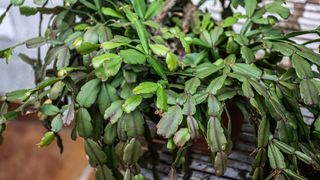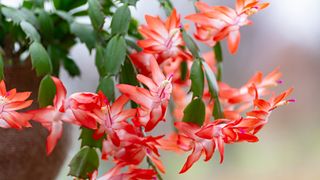The Christmas cactus (Schlumbergera x buckleyi) is a winter favorite, thanks to its sweep of brightly colored flowers that bloom every holiday season — making them a popular houseplant to gift over the holidays.
It’s certainly a statement plant that’s vibrantly hued at a time when so many other houseplants are lying dormant. But the Christmas cactus isn’t just a one-hit Christmas wonder, as it can live up to 20 years if cared for properly, and it’s a pet-friendly houseplant, too.
The foliage of a Christmas cactus is quite different from that of most houseplants. Rather than classic leaves, the Christmas cactus has long, fleshy, segmented stems that drape over the sides of its container. The segments are serrated and quite flat, creating a dramatic crown of silvery-green branches tipped with red, pink, purple, or white flowers. These blooms last for a couple of weeks — ideally over the holiday season.
If you’ve been convinced to acquire your very own Christmas cactus, you’ll want to ensure that you take care of it properly so that you’re rewarded with flowers annually. Unlike their desert kin, Christmas cacti originate from the Brazilian rainforest and so require different maintenance in order to thrive. They are surprisingly adaptable and able to flourish in many American climates — as long as you give them what they need.
Read on to find out exactly how to take care of your Christmas cactus, throughout the year.
Planting a Christmas Cactus

When you first bring home your new plant, it will likely be kept in a temporary starter container, which you will need to change. It’s also generally recommended that you place your Christmas cactus in an indoor container, since outdoor conditions may be too cold over the winter. If you live in a particularly mild climate, then you might be able to plant your cactus in the ground, but we recommend choosing an attractive planter.
The planter should have a drainage hole, to ensure that the soil drains properly after watering as well as providing better air circulation. Aim for a planter that is a few inches larger than its original container, so that there is sufficient room for the roots to grow. Over time, you may need to repot your cactus again into a larger home, if it grows a substantial amount. Repotting prevents the plant from getting root-bound and ensures that the cactus gets sufficient nutrients.
When moving the cactus from its initial container, make sure to take some of the original soil with it and fill around it with additional potting soil. Roots can be trimmed if excessively long, but aim to keep these in good condition to help the plant settle into its new home.
Christmas Cactus Needs

For a Christmas Cactus to thrive it will need a combination of light, moisture, and the correct balance of soil, fertilizer and temperature.
1. Light
Cacti require a good amount of sunlight, so it’s best to place your Christmas cactus in a window, where it can get hours of light. However, you need to find the balance between bright and indirect light, so that there is no risk of discoloration to the flowers. Some direct sunlight is fine, however, and many people like to place their cacti in an eastern facing window.
2. Water
The Christmas cactus prefers more water than its desert cousins and it is not drought-resistant, so be careful not to let the soil dry out too thoroughly. Allow the upper third of soil to grow dry to the touch before watering again and remember that your plant will need more watering if it’s in a particularly sunny spot. Reduce your watering when it’s time for it to flower, so the soil is only lightly damp (see more details below.)
3. Soil
The most important characteristic is that your soil is well-draining, hence the drainage hole in the container. If you can find a specific mix for cacti and succulents then definitely use that, but you can also use any sandy soil or soil rich in humus and nutrients. Ideal conditions include slightly acidic soil, so consider adjusting the pH levels for maximum blooming.
4. Temperature
Christmas cacti don’t need the arid heat of the desert, but they still prefer a mild climate or between 60-70°F during the winter. If you do experience a cold snap or two, your cactus should be fine to withstand brief periods of 50°F, but aim to keep the temperature conditions as consistent as possible to prolong the life of its flowers. During the peak growing months of spring and summer, warmer temperatures of 70-80°F are optimal. Some humidity is also good, so consider misting your cactus during the dryer winter.
5. Fertilizer
As with most plants, Christmas cacti benefit from fertilizing at the beginning of the growing season. Apply a general fertilizer with balanced NPK levels (nitrogen, phosphorus, and potassium) every two weeks during the spring and summer. Once buds have formed, stop fertilizing until the flowers begin to bloom in the winter. During flowering, you can resume feeding the plants on a monthly basis with a nitrogen-rich fertilizer.
How to prune a Christmas Cactus

Pruning isn’t required of a Christmas cactus, but it can be a good way to keep your plant in tip-top health over the years. If you notice that your plant has grown too leggy or that the plant simply seems to be looking a little tired, you can trim off one or two segments from the ends of the plant.
Be sure to use a sharp pair of pruning shears or scissors to make a clean cut — this will ensure that the plant heals quickly and healthily. In some cases you may be able to simply twist the segment off at the joint. However, only do this after the flowering season has finished in late winter.
How to make your Christmas cactus rebloom

Christmas cacti can be a little more high maintenance than other plants and so you may need to actively encourage your plant to rebloom each season. By adjusting some of its environment, you can send a clear signal to the cactus that it is time to flower.
It’s important to maintain a consistently cool temperature of 50-60°F during the flowering season, as well as to keep the plant relatively dry. Some recommend withholding water entirely during early October and only lightly watering every week or two once the flowers have set. Misting is recommended to keep humidity levels sufficiently high. Don’t fertilize until the blooms have fully emerged.
If possible, give your Christmas cactus 10 hours of light per day and 14 hours of total darkness to promote flower growth. It should take a few weeks for this to generate those young buds. Once they emerge, you can relax this schedule. When the blooms have begun to open, you can move the pot to a sunny spot so that flowers continue to grow. Be careful to keep temperatures generally consistent so that the plant doesn’t experience shock and drop its flowers.
More from Tom's Guide
- Discover 7 best houseplants for beautiful blooms
- And 5 low-light living houseplants to brighten up your home this winter
- Plus, how to care for a poinsettia in 6 simple steps





















 English (US) ·
English (US) ·